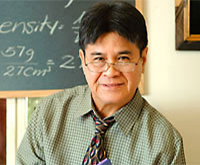Edgardo's Story
Lesson Learned: After multiple strokes, this teacher recommends following the doctor's advice
 A middle school teacher in Hyattsville, Edgardo Saddul is passionate about educating his students.
A middle school teacher in Hyattsville, Edgardo Saddul is passionate about educating his students.
"I want to touch their lives in a way that will make a lasting difference," the 66-year-old says. "My legacy is to give these kids a future to look forward to."
While Edgardo is usually the one teaching, last August he learned his own lesson about following his doctor's advice.
"My doctor had prescribed medicine for my high blood pressure, and I stopped taking it," he says. "As a result, I had multiple strokes of varying degrees over several days."
Serious Signs
The night before he was rushed to the Emergency Center, Edgardo experienced two signs of stroke. "I had a terrible headache and blurred vision," he says.
While he may have experienced a minor stroke that night, the next day he felt better and went to school. But the seriousness of the situation quickly became clear to Edgardo.
"I was giving instructions to the students, and I suddenly felt awful," he remembers. "My speech was slurred, and my body felt so heavy I couldn't move." He was having another stroke.
Quick Diagnosis
During a stroke, the brain's blood supply is disrupted, leaving brain cells without crucial oxygen and nutrients. As a result, the cells can start to die quickly. This makes treating a stroke a race against time.
Fortunately, the school nurse immediately called 911, and an ambulance took Edgardo to Holy Cross Hospital, which has been designated a Primary Stroke Center by The Joint Commission and the Maryland Institute for Emergency Medical Systems. Upon Edgardo's arrival, Holy Cross Hospital's stroke response team was called into action. This team is available for stroke evaluation and treatment
24 hours a day, seven days a week, and uses several tests to provide rapid evaluation and treatment options.
For Edgardo, magnetic resonance imaging (MRI) confirmed that he was having a stroke. An MRI uses magnets and radio waves to reveal abnormalities in brain structures. It is the most sensitive exam for detecting strokes.
Edgardo had multiple ischemic strokes. Ischemic stroke is the most common type of stroke, and it is caused by a blockage in an artery. This can occur in the head or in an artery in the neck leading to the brain. It may be due to a blood clot or the buildup of plaque that causes an artery to narrow.
Vital Treatment
"From the time ischemic stroke symptoms start, doctors have a three-hour window to begin treatment with a drug called tPA," says Andrew Barbash, MD, medical director, Neuroscience, Holy Cross Hospital.
"This drug restores blood flow and may stop an ischemic stroke, thus reducing its disabling effects."
Ashish Tolia, MD, hospitalist; Sharon Harriston, ACNP; and Aman Savani, MD, neurologist, managed Edgardo's care during his four-day stay in Holy Cross Hospital's Neuro Critical Care Unit. In this unit, a broad range of specialists- including medical neurologists, neuroradiologists and neurosurgeons-provide coordinated care and intensive patient management.
High blood pressure is a major risk factor for strokes. Dr. Tolia resumed Edgardo's blood pressure medication and prescribed antiplatelet medication to prevent the formation of blood clots and reduce the risk of additional strokes.
Hospitalists, such as Dr. Tolia, are physicians who focus their care on hospitalized patients and are essential to the expert care provided to stroke patients. As someone who knows genuine care and concern when he sees it, Edgardo says Holy Cross Hospital offers both.
"They did everything to save my life," he says. "Not in a mechanical way, but with great care and genuine concern. "My message to others is to follow your doctor's advice."
Stroke Signals: Learn to Recognize Them
A stroke can come on suddenly-at any time and in any place. So it's important to be able to recognize the signs, which may include:
- numbness or weakness in the face, arm or leg, especially on just one side of the body
- confusion or trouble speaking or understanding
- trouble seeing with one or both eyes
- trouble walking, dizziness, or loss of balance or coordination severe headache for no obvious reason
If you or someone in your company shows these signs of stroke, call 911 immediately.
